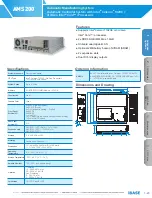
Printed in USA REV P 14-1219-0281
Instruction Sheet TA7894-300
9. Using a 1- 3/8" wrench with a handle of sufficient length to develop a
minimum of 1000 in-lbs (83 ft-lbs) torque, carefully remove seal housing
from bonnet.
CAUTION: Do not mar finish of stem.
10. Remove and discard pressure seal rings, jam ring and wiper o-ring from
seal housing.
11. Using a small wrench on the square section of the stem, unscrew stem
down and out through the bottom of bonnet by turning clockwise (as
viewed from top).
CAUTION: Stem inspection required.
12. Inspect the stem closely for definite signs of wear, nicks or scratches,
in the sealing area, see figure 1, Stem Sealing Area. If any mechanical
cleaning is needed, use emery cloth or paper (500-1000 grit) and polish
stem sealing area using a circular motion. Use the same criteria for the
packing nut wiper o-ring area of the stem, see figure 2, Seal Housing
Assembly. If any permanent damage is found discard the stem and
replace with a new stem.
CAUTION: Raised or sharp edges on the stem can damage and expand
the packing seals when pressing onto the stem.
13. Inspect the handwheel resting location where the stem changes from
square to round,
see figure 1 Handwheel Resting Location
. Remove
any raised edges or burrs using a fine file and emery cloth that are
higher than the stem diameter. Using an old seal, press seal on and
off this area to determine if any resistance is felt. Resistance may
require additonal clean up.
14. Remove and discard seal housing gasket, washer, and spring from bon-
net.
NOTE: Inspect stem** threads and mating threads in bonnet**. If any threads
show definite wear, discard part and install a new one.
15. Remove seat disc retainer nut by using 1-5/16" wrench to secure retainer
and another wrench to remove nut.
16. Remove and discard seat disc.
B. Reassembly
1. Install new seat disc into seat disc retainer by pressing into the recess
of seat disc retainer as shown in figure 3.
2. Apply Loctite 271
®
thread locking compound to the first three threads
of seat disc retainer.
CAUTION: Do not allow Loctite to contact seat disc.
3. Thread on disc retaining nut and tighten with a wrench to 240-270 in-lbs
(20-23 ft-lbs) torque. Stake nut in two places at retainer threads to prevent
loosening. See Figure 3. Set assembly aside.
4. Apply non-detergent grease liberally to threads of stem.
5. Screw the stem clockwise (as viewed from seat disc) into the bottom of
bonnet with great care to avoid damaging stem finish.
6. Install new seal housing gasket, new spring, new washer and jam ring
over stem and into bonnet.
7. Install new wiper o-ring in groove of seal housing.
8. Apply a thin film of non-detergent grease to the pressure seal rings and
carefully insert one at a time into the full depth of the seal housing.
9. Apply 1/8" stripe Loctite 271
®
thread locking compound across threads
in three places equally spaced around seal housing.
10. Place seal housing carefully over the stem to avoid damaging the edges
of seal rings and thread into bonnet. Tighten to 800 in-lbs (67 ft-lbs)
torque, using a 1-3/8" wrench with a handle of appropriate length.
11. Apply non-detergent grease to each side of new body gasket and install
into body.
CAUTION: Using the handwheel, verify the stem is in the full open (valve
back seated) position to prevent seat disc from being forced against seat
when bonnet is assembled to valve body.
12. Place bonnet over body and align holes for cap screws.
13. Install (4) cap screws, hand tight.
14. Using appropriate wrench, tighten bonnet cap screws to 540 in-lbs (45
ft-lbs) torque using a crisscross tightening sequence. See Figure 4.
15. Place handwheel and information disc on stem, secure with washer and
locknut and tighten firmly with a small wrench.
16. Apply non-detergent grease to each side of flange gasket then install in
body.
17. Reinstall flange to outlet and hand tighten (8) flange cap screws.
18. Torque each flange cap screw 300 in-lbs (25 ft-lbs) minimum using a
crisscross tightening sequence. See figure 4.
19. Turn handwheel to closed position for Bench Test.
Bench Test
1. Torque handwheel to 400 in-lbs (33 ft-lbs). Verify outlet is open.
2. Pressurize valve to 300-500 psi (through the inlet connection) and check
valve for leakage, when looking into the outlet port, by applying a high
quality leak detection solution around seat area and seat cavity. Observe
for one minute to detect leaks.
3. Release 300-500 psi, apply 15-20 psi and look for any leakage as above.
4. Install outlet plug, again apply 300-500 psi and slowly open valve by
turning handwheel 1/4 turn incrementally. Check valve for leakage by
applying a high quality leak detection solution around stem, seal housing
and bonnet joint. Continue to rotate handwheel 1/4 turn incrementally
until valve is fully open (not back seated). Observe for one minute to
detect leaks.
CAUTION: Wrenches must never be used to operate valves equipped with
handwheels designed for hand operation.




















